
周記 蘭州牛肉面 難波本店
shuukiranshuugyunikumen ◆ 周記蘭州牛肉麺
3.26
Ebisu, Imamiya, Ashihara
「Ramen」
2,000-2,999円
1,000-1,999円
Opening hours: Lunch 11:00-15:00(L.O.14:40)Dinner 17:00-22:00(L.O.21:30) Open Sunday
Rest time: None
大阪府大阪市浪速区難波中3-16-12
Photos
(20)

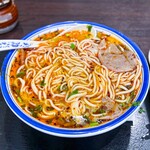


















Details
Reservation Info
can be reserved
Children
Children are allowed (infants, preschoolers, elementary school students), children's menu available, strollers allowed
Payment Method
No credit cards
Electronic money is not accepted
Number of Seats
42 seats
Private Dining Rooms
None
Smoking and Non-Smoking
Smoking: 28 seats Smoking: 14 seats Non-Smoking: 14 seats The Law Concerning Measures Against Passive Smoking (Revised Health Promotion Law) has been in effect since April 1, 2020, so please check with the restaurant before visiting as it may differ from the latest information.
Parking
None
Coin-operated parking available nearby
Facilities
Stylish space, calm space, sofa seating available, wheelchair accessible
Drink
Sake available, shochu available, cocktails available
Comments
(21)
蘭州R
4.00
Personally, a dish that I have a lot of attachment to is the Lanzhou beef noodle. This was my second time trying it in Japan, and I found this restaurant to be much more satisfying than the first one. When I entered, they were speaking Chinese, and I thought to myself, "Oh, they seem Chinese!" The signboard advertised Lanzhou beef noodles set, so I ordered that. The set came with a side of cold dishes, and I could choose the shape of the noodles which were then freshly made to match my preference. Compared to Japanese ramen noodles, I might find these noodles a bit lacking, but they had a good texture and flavor. The beef soup had a unique Chinese aroma and spices. Some people might have different preferences for this kind of taste. I remembered a tip I was given before and added black vinegar midway through the meal. It's a perfect dish for a cold day. There were both Chinese and Japanese customers when I visited. By the way, the two staff members were Chinese. They asked me, "How is it?" This place truly captures the authentic taste of China. It's amazing how some restaurants in the city can be so inconspicuous from the small entrance but spacious inside. The kitchen was also spacious, and there was a counter with alcohol and a TV screen showing CCTV. The atmosphere was great. There were other items on the menu that caught my eye and made me want to try them. This is definitely a place worth revisiting.



masayan.310
3.40
The interior of the store has a unique Chinese atmosphere with scents like octagon and Chinese language being spoken. When I visited after a long time, they had added counter seats and comfortable sofa seats. I ordered the "Lanzhou Beef Noodle" A set for 1,200 yen, choosing thin noodles from 8 different types. The noodles are stretched by hand after ordering, and the long, chewy noodles are served in a bowl of soup made from beef bones and spices, topped with coriander and chili oil. The noodles have a chewy texture similar to udon but not quite like it. The beef bone soup is the highlight of this dish, with a rich flavor complemented by the refreshing taste of coriander. If you want more spiciness, there is chili oil on the table. This traditional Chinese soul food is irresistible once you see it, with its unique and delicious taste.




ふるふる7
5.00
This restaurant is known for its delicious Lanzhou beef noodles as its signature dish. However, not only that, other menu items also offer fantastic flavors. Personally, I love the lamb soup, which always impresses me with its rich taste. The lamb soup has a deep umami flavor, and the warm soup warms both the heart and body. It is highly recommended, especially when tired or on a cold day. Additionally, dishes like liangpi and cucumber beef salad are also excellent. Liangpi is a refreshing cold noodle with a chewy texture and a refreshing taste that stimulates the appetite. The cucumber beef salad combines the refreshing cucumber with tender beef in a perfect harmony. Each dish offers an authentic Chinese taste, perfect for lunch or dinner. The atmosphere of the restaurant is relaxing, making it ideal for dining with family or friends.

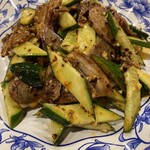
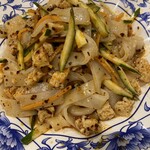

ぷりあん
3.20
The appearance, the smell inside the restaurant, and the customers all exude a strong local vibe that is enjoyable. I ordered the C set noodles with beef noodles, side dishes, and scallion pancakes with thin noodles. The dish is full of cilantro, has a gentle flavor, and a strong aroma that I like. Check out their Instagram @puribi518.




あやみ0419
3.00
It was a restaurant I wanted to visit once for its authentic cuisine and atmosphere. I ordered ramen and lamb skewers. The ramen looked different from what I expected, but the taste was not too strong and delicious. The lamb meat was also good. The restaurant is spacious, but had a somewhat lonely atmosphere. It truly captures the taste of the authentic cuisine.


のろのり1004
4.00
I am "Noronori," who mainly walks around eating lunch, mainly in Sakai. The original source is https://ameblo.jp/norinoribenben20072000/entry-12760596245.html. I had been curious about this restaurant with a sign visible from the Motomachi 3 intersection for a long time. As soon as I entered, there were counter seats and table seats at the back. I sat at the second table from the back. There are many menu items and many things I want to try, but... my target is the Lanzhou beef noodles! They stretch the noodles after the order is placed. I asked for thin noodles. You can choose from 8 different noodle thicknesses. The soup was so delicious! It has various flavors, but it is refreshing without any unpleasant taste, and it's just so delicious♪ I love tonkotsu, salt, and soy sauce, but this was so good that I forgot about all of them (*_*; If you feel it's spicy, you should bite into the daikon, it works well. This is a bowl that makes you want to eat it again! There were also various dishes from the ethnic cuisine of the northwest region of China, so I am interested in those too. Thank you for the meal.




bunbu867
3.80
The soup is light yet flavorful, with plenty of chili oil but not too spicy. You can choose the thickness of the noodles, and they cook them fresh to order. The noodles are soft and have a gentle flavor, very delicious. Adding cilantro (150 yen) might be a good idea. The customers are half Japanese, half Chinese. Although the restaurant is named Lanzhou Beef Noodles, they also offer other meat dishes, stir-fries, and side dishes like mapo tofu. They also have noodle dishes without soup and stir-fried noodles. Today, I tried the Lanzhou Beef Noodles, but I would love to try other items on the menu as well.


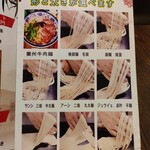

fromosaka
3.40
I tried Lanzhou beef noodles at another restaurant and wanted to taste other Lanzhou dishes as well. I found a place called "Zhouji Lanzhou Beef Noodle Namba Honten." Although the name sounds like a noodle specialty shop, only about 20% of the menu consists of noodles. The chefs are also from Gansu Province, where Lanzhou is located. The nearest station is Daikokucho, about a 10-minute walk north from the No.1 exit. It's located north of the Osaka Chinese School. While it appears to face Yotsuhashi Street on the map, it's actually the second shop after turning east at the corner of Don Quijote. It's close to Daikokucho but quite a distance from Namba if you walk. The name "Namba Honten" seems a bit strange. I ordered while confirming with the staff if it was Lanzhou cuisine, as the menu also includes dishes from Northeastern and Sichuan cuisine. The lamb skewers had crushed cumin sprinkled on them, which made the flavor milder and more enjoyable compared to Northeastern cuisine. I didn't know where Lanzhou was, so I looked it up. Lanzhou, where the Yellow River flows east to west, has been a strategic point on the Silk Road since ancient times. It was originally part of Longxi Commandery during the reign of King Zhaoxiang of Qin, and Jincheng Commandery was established by the Han. In the 3rd year of the Kaihuang era of Sui, Lanzhou was established with its current name and is now the capital of Gansu Province. Gansu Province borders Xinjiang Uygur Autonomous Region, Qinghai Province, Ningxia Hui Autonomous Region, Inner Mongolia Autonomous Region, Sichuan Province, and Shaanxi Province. The Yellow River crosses the central part of Gansu Province and extends northwest. This is the Hexi Corridor, a gateway to the Western Regions of the Silk Road, and during the Tang Dynasty, China was believed to end at Jiayuguan. Lanzhou has a large population of Hui Muslims, giving it an Islamic cityscape. Therefore, Lanzhou cuisine is halal, with no pork used, unlike most Chinese cuisines. Lanzhou hand-pulled noodles, invented by Ma Baozi, a Hui man during the Qing Dynasty, are made with naturally salty water, giving them a unique texture different from other Chinese noodles. The noodles range from thin as vermicelli to wide flat noodles over 5 centimeters, and they are hand-pulled upon ordering. The soup is seasoned with cilantro, radish, and young garlic leaves, and authentic Lanzhou noodles are topped with spicy oil, turning the light soup red. The authentic taste can be distinguished by the color of the soup. The authentic flavor is indescribably delicious and an essential part of Lanzhou people's lives. Noodles with beef in a spicy sauce symbolize longevity and are served on birthdays. In everyday cooking and casual eateries, there are lamb skewers, lamb dumplings, beef noodles, lamb noodles, and pork-free fried foods like noodles and fried rice. The seasoning includes cumin and cilantro, giving a unique flavor profile to dishes like ramen and fried rice. I edited the dishes I received into a video, so please check it out if you're interested. https://youtu.be/AxO1hvtASrA




GOGOGO5
3.70
I stayed at a nearby hotel and was recommended to come here for the first time. I was really surprised by the authentic taste! The noodles are incredibly delicious! They mentioned that you can have it without cilantro and chili oil, but this time I had both and the soup was also delicious, so next time I might try it without them.




たこやきくん
3.50
Lanzhou Ramen from the homeland, a shop run by a shop owner from Gansu Province, China, "Zhouji Lanzhou Beef Noodle Namba Main Store". Over there in that country, they write noodles as "面" ... (・´з`・) But still, the recently popular Lanzhou beef noodles are gaining attention. Let's dive into lunch. Upon entering the store, the atmosphere is very spacious and exotic. It is a non-smoking environment with no background music (28 smoking seats, 14 non-smoking seats). They have a system where you can choose the thickness of the noodles when ordering. (Round noodles) Thin, medium, thick, (Flat noodles) leek leaf, thin wide, wide, (Triangle noodles) buckwheat needle, a total of 7 types. When I asked for a recommendation since I was not sure, they suggested the second thinnest (medium). Toppings include cilantro, extra beef, homemade egg, and side dishes. Conversely, cilantro and chili oil can be omitted. The recommended menu item is the Lanzhou beef noodle set. When ordering, I asked for the wide flat noodles. The owner seemed a little puzzled, so I quickly said, "Byan Byan noodles please." Furthermore, when asked, "Cilantro and chili oil okay?" I responded with, "Okay, okay!" but it felt like something was off. Once the order was placed, the sound of noodles being made could be heard from the kitchen. The origin of Byan Byan noodles is said to come from the sound of pounding the noodles. At the back of the store, a group of Chinese people were talking loudly, and the staff were interacting in broken Japanese. The water is self-serve. Lanzhou Beef Noodles 880 yen. It was my first time trying Lanzhou beef noodles, so I kept it simple with the default toppings. According to the menu, Lanzhou beef noodles are characterized by a rich soup made from over 20 types of spices and beef bones simmered for over 5 hours, with freshly made hand-pulled noodles topped with chili oil, cilantro, etc. You can choose your preferred shape and thickness of the noodles. The presentation of the dish with a lot of chili oil and cilantro looked delicious. The aroma of cilantro adds an exotic touch. First, I tasted the clear soup which was refreshing with no unpleasant flavors and full of umami. When I drank the soup with a lot of chili oil, the umami flavor was stronger than the spiciness. Mixing the chili oil and cilantro in the soup gave an ethnic flavor with a punch from the cilantro. The chili oil had a good balance of spiciness and umami, making the soup light and flavorful. The noodles were the popular Byan Byan noodles. They were freshly made, chewy, and had a good texture. The wheat flavor was also noticeable. When I mixed the noodles with chili oil, it was not as spicy as I expected! Very tasty! The portion was generous, and it felt like it never ended. The meat consisted of four slices of well-cooked beef leg meat and radish slices. The radish did a great job of refreshing the palate. I really liked this! If you really like cilantro, it's a different story, but for those who want to fully enjoy the soup's flavor, it might be better to skip the cilantro. That way, you can better appreciate the taste of the soup. In conclusion, for Byan Byan noodles, it might be better not to slurp like regular ramen. Since the noodles are wide, slurping can cause the soup to splatter everywhere, including on your clothes. If you really want to slurp vigorously, bring an apron or something! Alternatively, going shirtless might be recommended. It's an authentic ethnic dish that you can't experience at regular ramen shops. There is also a branch in Nihonbashi. Bon appétit.




芋洗坂グループ長
2.50
It was a rainy Sunday in Namba, Motomachi. I wandered around looking for a shop and came across Lanzhou Beef Noodle. The exterior gave off a Chinese vibe, so I decided to give it a try. I had been here before when it was a cheap cafe. The entrance was spacious, and I sat at a table in the back after folding my umbrella. The menu had a variety of options, including different types of beef noodles, side dishes, and other dishes like dumplings and beef and lamb dishes. I chose the A set, which included beef noodles, side dishes, and an egg for 1100 yen, which seemed a bit pricey. I went for the signature dish, which was noodles cooked in beef bone soup with 20 spices. The staff asked if I was okay with cilantro, to which I said yes. After a short wait, the noodles arrived. The restaurant was mostly filled with Chinese customers who were a bit noisy, but they left by the time my noodles arrived, so I could enjoy my meal in peace. The Lanzhou Beef Noodle had black-colored noodles with thin slices of beef, a boiled egg, and a spicy sauce in the middle. The soup had a light, refreshing Chinese flavor with a hint of spices. The noodles were soft and had a fluffy texture. The beef slices were small and thin, not very satisfying. Overall, the meal was underwhelming, and I decided not to come back. It's important to be careful when choosing a restaurant on a rainy day. Thank you for the meal.




キャップ
3.40
The store name has "Lanzhou" in it, so I visited with great interest. Lanzhou is geographically and historically close to Mongolia in China, with a large population of Hui Muslims. They cook halal dishes without using pork. One of their food cultures is Lanzhou ramen, which many people may not have tried yet. The atmosphere of the restaurant is not like the typical Shanghai or Cantonese style, but more like the Northeastern cuisine found in Osaka. They use seasonings and ingredients like cumin, coriander, and traditional Chinese herbs. The restaurant mainly has table seating with a good number of seats available. I went for the lunch set menu, which included the C set - Lanzhou ramen with side dishes and scallion pancakes for 1380 yen. You can choose from 9 different types of noodles, including round, flat, triangular, and thick noodles. The staff asked me if I was okay with coriander and which type of noodles I preferred. I chose the second thinnest noodles and said I was fine with coriander. The Lanzhou ramen was delicious, with a slightly strong salty taste. The noodles were also very tasty. The scallion pancakes were made of wheat flour dough with oil and thinly sliced scallions, similar to naan bread. It had a local Chinese food vibe, and I personally enjoyed it. However, tastes may vary. Overall, it was a great meal!

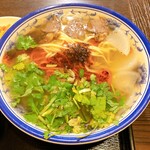


yoyoyo yossy
3.80
Before wandering around Osaka, my friend took me to a hot topic Wuhan cuisine restaurant, but it was closed. As an alternative, we ended up at this Lanzhou ramen shop. The shop mainly serves ramen for the general customers, but it is known for Lanzhou cuisine, which is a Hui Muslim cuisine similar to Uyghur cuisine and close to Xi'an. Despite being advertised as a beef noodle shop, there were more lamb dishes on the menu. A knowledgeable person in this cuisine ordered for us, and we had dishes like hot and sour lamb soup, lamb dumplings, smashed preserved egg with cucumber, three-color cucumber salad, shredded potato, grilled lamb skewers, stir-fried lamb tripe, beef noodles (with a choice of noodle type), squid balls, pilaf, mint toast, and liangpi. All the dishes were of high quality! The presence of dishes like pilaf hints at some Central Asian influence. The homemade noodles for the beef noodles were especially delicious. The toasted bread was spiced similarly to the lamb skewers, which we all tried to analyze. The total bill came to 1500 yen per person for food, and those who drank alcohol paid extra. I had a beer, which cost me 2000 yen. Despite eating a lot, it was a very reasonable lunch. The menu was also in Chinese, indicating that Chinese customers also visit this place.




aruko☺︎
0.00
When I entered the restaurant, I was greeted by exotic scents. While I had no problem with it, my companion who insisted on coming seemed to struggle with it. I ordered beef noodles, which surprisingly came with round noodles (laughs). My companion avoided cilantro and opted for the safe daily special instead. I wonder why they wanted to come here in the first place??? The light and clear soup had a hint of spice to it. The chili oil and cilantro added a nice touch. I found the flat noodles interesting. "Thank you for the meal ☺︎"

TAR-KUN
2.80
"Lanzhou Beef Noodle" Lanzhou-style ramen made with beef bones, a hand-pulled noodle dish that is becoming more popular in Kansai. I visited the Namba Honten branch of Zhouji Lanzhou Beef Noodle this time. I arrived at the restaurant before 8 p.m. The noodles are hand-pulled in the spacious back of the restaurant. Looking at the menu, I ordered the Lanzhou Beef Noodle for 850 yen, choosing the Daikwan noodle option out of seven types. When the ramen arrived, the noodles were hand-pulled flat noodles. They were delicious noodles with a smooth and chewy texture, similar to the amazing flat noodles from Norikidou in Gifu. The soup is made with over 20 types of spices added to beef broth. It has a medicinal soup-like flavor, completely different from Japanese ramen. The aroma of the spices, the spiciness of the chili oil, and the strong fragrance of coriander blend together to create a soup with a very distinctive character. For toppings, there were beef, daikon, and coriander that we requested on a separate plate. We went with a group of four and shared thin noodles, flat noodles, and triangular noodles, each with their own unique characteristics. It was great to be able to enjoy different types of noodles. Thank you for the meal."

ぶぅ♪
2.50
"Weekly Ramen: Lanzhou Beef Noodle at Namba Main Store in Osaka City for 850 yen. You can choose from 7 different types of noodles with varying thickness and shapes, and I chose the leek leaf noodles. It's rare to see a ramen shop where the noodles are hand-pulled upon ordering. I remember being impressed by the amazing technique when I saw hand-pulled noodles being made right in front of me at 'Tenmon' in Miyazaki. The leek leaf noodles have a chewy texture with a hint of freshness from the wheat. The soup is a medicinal herb-flavored broth made with over 20 types of spices added to beef bones. Once you add cilantro, it takes over the entire flavor profile. Toppings include daikon radish and beef chashu. The thin, wide, and soba-style noodles chosen by my companions each have their own unique characteristics, with the wide noodles making a particularly strong impression similar to the amazing flat noodles at 'Rikidou'. ★Instagram https://www.instagram.com/ramenbukun ★Twitter https://twitter.com/ra_men_tabi"




吟遊食人
3.00
Recently, there's been a lot of talk about Lanzhou beef noodles, and I went to Zhouji Lanzhou Beef Noodles in Namba Motomachi. The area near Naniwa Ward Office is a fierce battleground for ramen shops. This Lanzhou Beef Noodles shop is more of a Northwestern Chinese cuisine restaurant than a ramen shop. They also have dishes like Liangpi, and for the Lanzhou beef noodles, you can choose to have it with or without cilantro. I think it's more delicious with cilantro for the aroma. For those who don't like cilantro, you can choose without, but I don't think it would be as tasty. The soup is not too spicy when mixed with the noodles, but it becomes quite spicy when you drink it. It's different from hot and sour soup, a bit spicy, slightly sour, and oily. It might be good for those who like spicy oil and cilantro. You can choose from three types of noodle thickness - round, flat, and triangular, with seven combinations including triangle noodles. I chose the middle thickness of the flat noodles, and they were quite wide and chewy. I got the C set, which came with a scallion pancake-like dish and a boiled potato and carrot salad-like dish, all for 1380 yen. The Lanzhou beef noodles alone cost 850 yen. Next time, I might try the thinnest round noodles. I didn't realize there was Lanzhou beef noodle cup noodles as well.




ぐらんごじぇ
0.00
I went to Zhouji Lanzhou Beef Noodle near Kuzu Market in Lanzhou, Gansu Province to try their famous beef noodles. The noodles are hand-pulled in the shop, and you can choose the thickness. There are 7 options, including round noodles (thin, medium, thick), flat noodles (thin, medium, thick), and triangle noodles. You can also choose to add cilantro and chili oil. I ordered the thickest flat noodles, called "Da Kuan", and added 2 lamb skewers. The soup, made with beef bones, had a rich flavor enhanced by cilantro and chili oil. The noodles were about 3cm wide, slippery and difficult to slurp, but had a chewy texture. Despite being a bit challenging to eat, the perfect balance of spiciness, richness, and sweetness in the soup, along with the tender beef slices, made it delicious. The lamb skewers were also tender and perfect with beer. Lanzhou beef noodles are known for incorporating 5 elements: clear soup, daikon, spiciness, cilantro and garlic, and shiny yellow noodles. This place offers an authentic taste of Lanzhou noodles. Next time, I'll try the mixed noodles and egg dish.




tabitito
3.00
I first encountered "Lanzhou beef noodle" when I visited a restaurant near Nihonbashi Station. I was delighted to see the noodles being freshly made in the back of the store, giving me a sense of authentic Chinese food culture. The soup is different from Japanese ramen, with a refreshing taste and a slightly sweet and spicy flavor in the beef. The quality of the meat and the seasoning are better compared to other places I've tried. There are also other grilled items like lamb skewers available. There are still many unfamiliar dishes to try, and since it's close to Namba, I will definitely come back again.




ササラモサラ
3.50
I finally got to visit a restaurant that I had been curious about for a while. It's called "Shuki Lanzhou Beef Noodles" in Namba, but it's actually quite far from Namba, closer to Daikokucho. It seems to be run by a Chinese couple. Right from the start, they greeted me with "irasshaimase, 你好 (´Д` )♪" (laughs) There were indeed many Chinese customers there. I quickly ordered their signature dish, "beef noodles," and my favorite, "lamb dumplings" (´Д` ) I could see the owner in the back kneading and stretching the noodles diligently. It looked very authentic (´Д` ) They offer 7 different widths of noodles, and I chose the widest one called "Daikwan" (´Д` ) It was much thicker than udon noodles, very satisfying. The soup was a clear beef bone broth with various spices, chili oil, and coriander. It wasn't too spicy and very easy to drink, which I liked (´Д` ) The lamb dumplings had just the right amount of unique flavor for me (laughs) I enjoyed them with black vinegar and chili oil (´Д` ) The chewy skin was excellent (´Д` ) They also had other authentic dishes like "grilled lamb skewers." I can't believe I managed to resist having beer with this meal, I want to pat myself on the back (laughs) Next time, I'll come back for a hearty meal of lamb and beer in the evening (´Д` ) It's close to my place, so I'll definitely visit again (´Д` ) Thank you for the delicious meal.




tad
3.40
Today's dish was round log noodles. It was hard to pick up with plastic chopsticks haha. The challenge menu for today was lamb skewers. Cooked at a low heat and delicious. It was even better with added coriander. I want to try it at other stores, but I wonder if there are any in Osaka. I recommend trying it once.


Email Login